Are you looking to grow a holiday plant? Here’s a detailed Poinsettia Care Tips & Growing Guide that will help you grow it to its full potential!
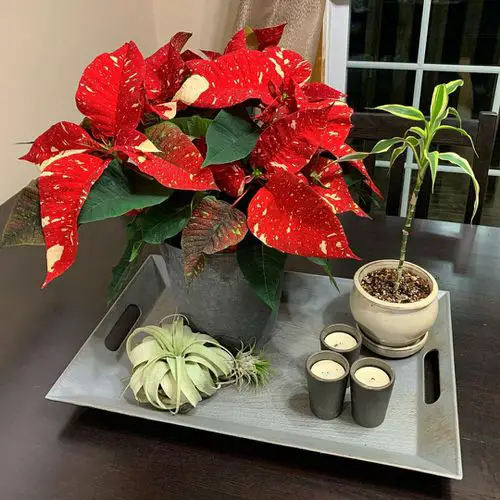
Poinsettias are one of the most popular holiday plants, synonymous with Christmas décor and festive cheer. If you want it to thrive at the festive time, then here’s a detailed Poinsettia Care Tips & Growing Guide to help you out!
Botanical Name: Euphorbia pulcherrima
Common Names: Mexican flameleaf, Poinsettia, Christmas star
USDA Zones: 9–11
Here are the best types of Poinsettias you can grow indoors
Poinsettia Information
The Poinsettia plant is a shrub that blooms in a cluster of small flowers in shades of yellow surrounded by huge red-colored floral bracts that are basically modified leaves.
This plant is also called Mexican Flameleaf, and this plant is forced into blooming just in time for the holiday season.
Best Types of Poinsettias
-
Prestige Maroon: A darker shade of the standard red poinsettias with large oak-shaped leaves.
- Princettia Red: The ‘Princettia Red’ bracts have a hot pink hue outlined with thin white lines from its edges, making each bract stand out from the other.
-
Viking Red: Known for its cold tolerance, the ‘Viking Red’ poinsettias boasts exotic crimson-colored bracts with rounded margins.
-
Classic White: This poinsettia cultivar displays creamy white to yellowish bracts in a slightly upright position. ‘Classic White’ poinsettias thrive in warmer climates.
-
Princettia Pure White: As the name suggests, this variety of poinsettia shows pure white bracts with green veins. The dark green foliage gives a sharp contrast to its look.
-
Christmas Beauty Nostalgia: With a dreamy hue, this cultivar shows variegated red-veined bracts in pale pink and yellowish-green shades.
-
Visions of Grandeur: One of the best varieties of poinsettias that display ruffled bracts in pale creamy yellow to pale pink shades.
-
Jingle Bells: This poinsettia cultivar comes in bright crimson colored oak-shaped bracts with white specks. As the name suggests, ‘Jingle Bells’ will add the perfect merry vibe to your space.
-
Peppermint Ruffles: Resembling ‘Visions of Grandeur’, this variety has wavy bracts in the pale pink shade with yellow veins.
-
Carousel Dark Red: A unique cultivar that shows small dark red wavy bracts. The dark green leaves are pretty sturdy as compared to other varieties.
Propagating Poinsettias
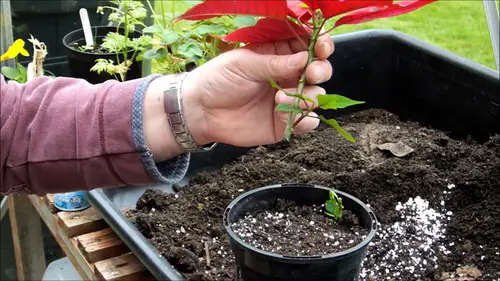
There are two methods of plant propagation for Poinsettia and it could be done via stem cutting or planting seeds.
From Seeds
- Get seeds from a local nursery or a garden center.
- Sow the seeds in a seed starting mix.
- Moisten the growing medium evenly and keep the pot where it gets bright, indirect light.
- The seeds will germinate in 2-4 weeks.
From Cuttings
- Snip off 4-6 inches long cutting from a healthy plant.
- Dip the end in a rooting hormone and plant it in a well-draining growing medium.
- Place the cuttings in a spot that receives bright but indirect sunlight.
- Cover the container with a plastic cover to enhance humidity.
- The cuttings will root in 4-5 weeks.
Poinsettia Care Tips & Growing Guide
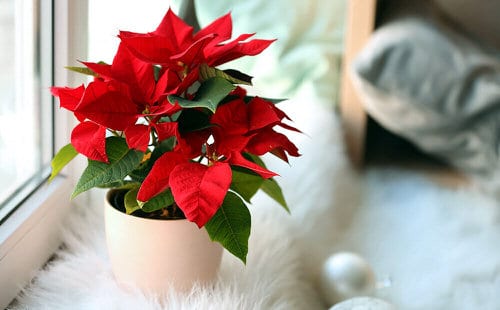
Location
Place the plant at a location where it gets at least 3-4 hours of direct sunlight. Do make sure that you are not exposing it to harsh afternoon light.
Contrary to a popular belief, Poinsettias can do well in a few hours of direct sunlight every day as it helps them to get a deep color.
Soil
Avoid using garden soil for growing Poinsettias. Always go for a growing medium that is light and well-draining. You can buy any good quality, peat-based potting mix for the plant.
Watering
This beautiful plant needs water whenever the topsoil feels a bit dry to touch. It is best to water the soil thoroughly until water runs out through the drainage holes at the bottom of the container.
Overwatering has the potential to kill the plant and wilt the leaves, so avoid it at all costs.
Temperature
Poinsettias do best in a temperature range of 65-75°F or 18-23°C. Keep the plant away from any cold or hot drafts.
Get the tips to make arrowhead plant bushier and full here!
Poinsettia Plant Care
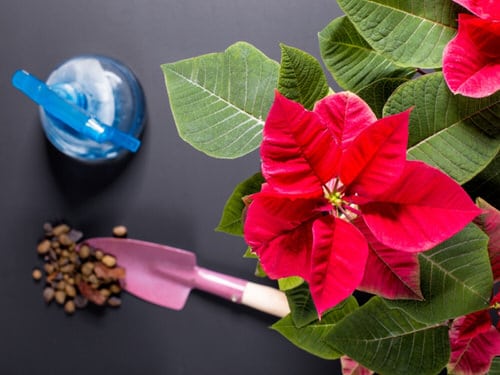
Fertilizer
Avoid feeding the plant when it is blooming. During its growing period, fertilize it with a balanced blend like 20-20-20, once in 4-5 weeks. Once the plant starts to show new leaves, you can increase the frequency to once in 2-3 weeks.
Do follow the instructions on the label for the right dosage.
Pruning
Around April, it would be a nice idea to prune back the plant to about 1/3 of its growth. If you want to keep it compact, prune it accordingly. You must mist the plant after pruning to limit the seepage of the latex. This will also help the plant from drying out.
Pinch back the stem’s end at around the end of July or early August. It will make the plant bushier. Make sure you are not pinching the plant in September as it will prevent it from blooming.
Pests and Diseases
Poinsettias are prone to whiteflies, mealybugs, powdery mildew, thrips, and gnats. Get rid of them using an insecticidal soap or neem oil solution.
To keep the majority of diseases at bay, avoid overwatering the plant and keep it at an airy location.
Looking for natural fragrant air fresheners? Check out these houseplants!
How to Rebloom Poinsettias After Christmas?
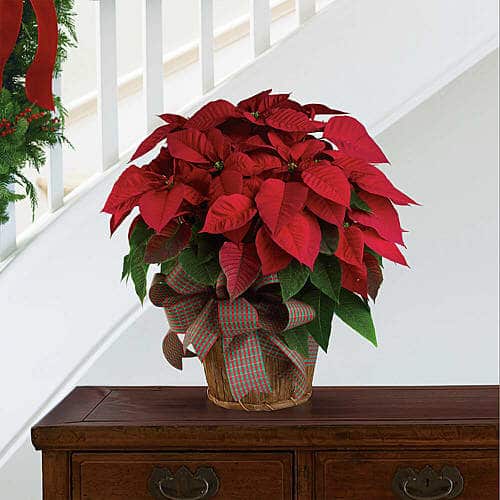
Though Poinsettias look fantastic with their foliage, most people are interested in making them bloom again after the festive season. Though it might not be an easy task to make the plant flower again, it can be done with the right care. Here’s how:
- January – March: You don’t have to do much other than saving it from winter and watering the plant when the topsoil feels dry to the touch. Do not overwater the plant.
- April: Cut down the watering a bit and let the soil go dry a bit more. Do make sure that the stems are not getting dry in the process. After 1-2 weeks, keep the plant at a spot where it gets no sun for 12-15 hours. Maintain a temperature of 60-65 degrees Fahrenheit.
- May: This is the month when you need to re-pot the plant using a fresh potting mix. While re-potting the plant, cut the stems by 3-4 inches. Keep it at a location where it gets a bright, indirect light—an east-facing window would be the best. Make sure the plant gets a temperature of 65 to 75 degrees. Also, fertilize it with a 20-20-20 blend once in 2 weeks. Do follow the instruction on the label.
- June: Come June and keep the plant in the garden where it gets bright but indirect light. Continue to water it when the topsoil goes a bit dry, and fertilize it once in 2-3 weeks.
- July: This is the right month to pinch back the stems of the plant by 1 inch. It will force the plant to grow more stems while keeping it compact, preventing it from going lanky.
- August: Keep on pinching the stems of the plant. After 10-12 days, bring the plant indoors (mid-August). Place it on an east-facing window or somewhere where it gets direct sunlight for 3-4 hours.
- September: Keep the plant at a location where the temperature stays above 65 degrees Fahrenheit. Keep a close tab on watering and feeding.
- October: This is where you need to be very careful with the plant. Starting from the 1st day of the month, keep the plant in a dark location, away from any light source, from 5 PM to 8 AM.
- EXPOSING THE PLANT TO ANY SOURCE OF LIGHT WILL HAMPER THE BLOOMING. During the daytime, keep at a bright window and water when the topsoil goes a bit dry.
- November: Continue to repeat the process like the month of October till the 4th week of November. During the mid of the 4th week, the plant will start to grow the flower buds. This is the time when you need to stop keeping the plant in complete darkness from 5 PM to 8 AM.
- December: Around the second week of the month, stop feeding the plant. If you have followed all the steps in the right manner till November, your poinsettia will be in full bloom!
Poinsettias Toxicity
Keep the plant out of the reach of pets and children, as it can cause mild signs of drooling, vomiting, and diarrhea if ingested. It also oozes out milky sap from the stems, which can cause irritation and swelling of the skin.


